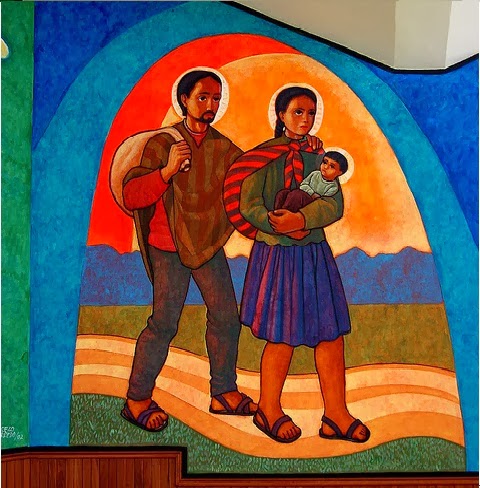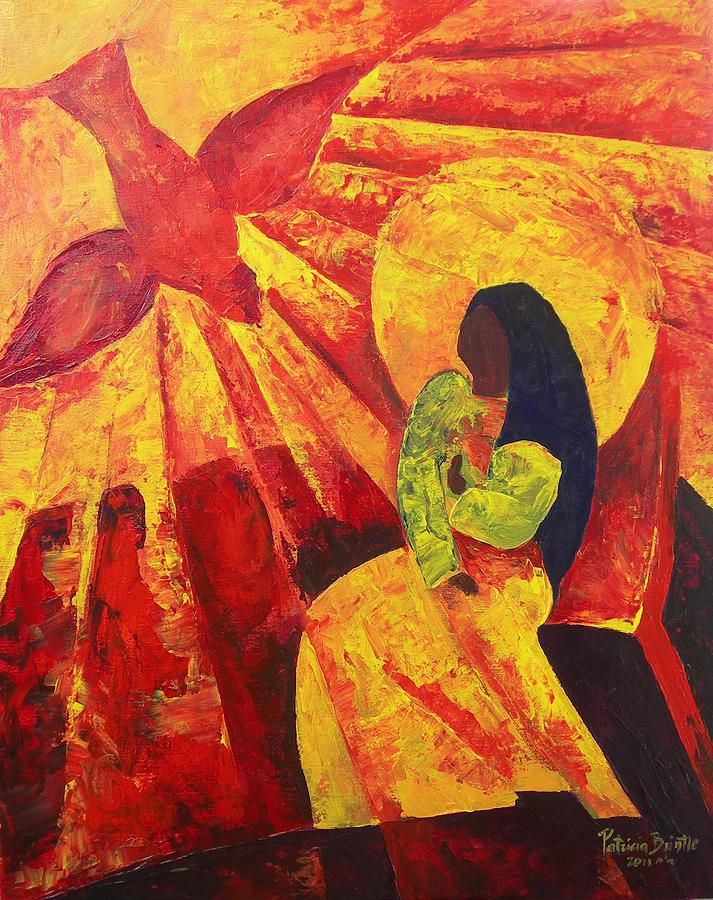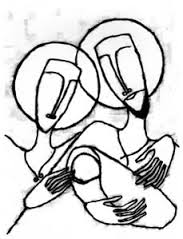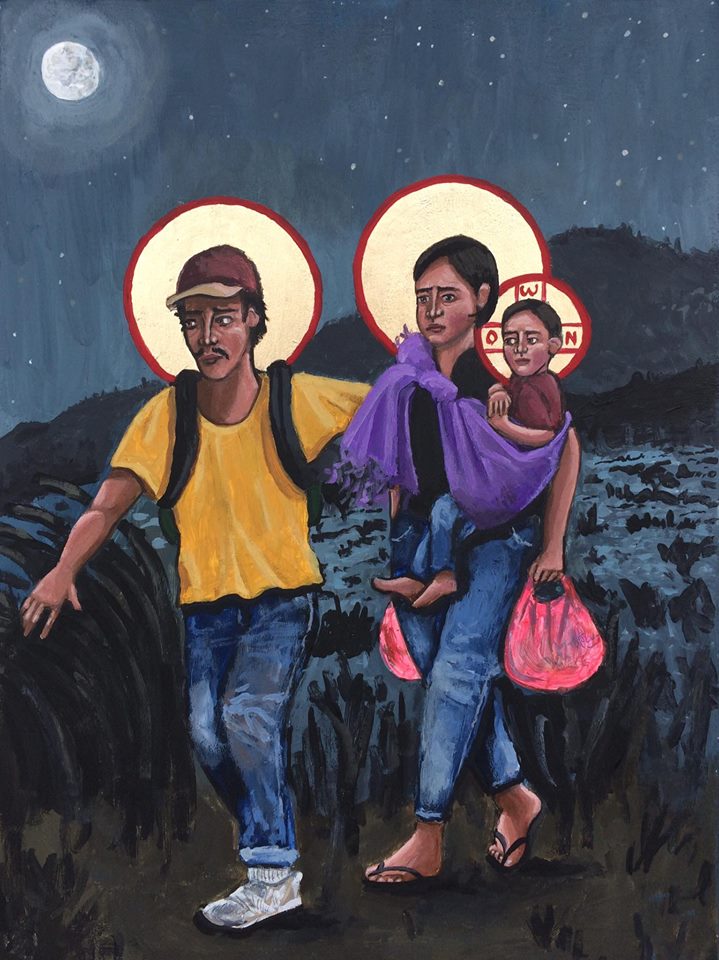Psalm 80:1-3

How shall we receive the Holy family as they come into our midst this week? The brief lines of their biblical stories have been layered over by so much art, so many hymns, so much tradition, that we may forget what is actually written there. The story that we think we know has become so familiar, it may not feel like something that could touch and change our lives today.
But we long now, as folks have longed for generation upon generation, for God to come close to us, and to change our world. The psalmist cries: “Stir up your might, and come to save us!… Let your face shine, that we may be saved.” Christians are invited to find God’s response to this longing in the events of this week. Let us make our hearts ready to receive God, shining and saving, arriving in the form of a human child.
Luke 1:26-38

We know very little about Mary of Nazareth, the mother of Jesus: but that hasn’t stopped us from celebrating her. There are so few women with names in scripture; so few who speak; so few who are portrayed as taking an active role in making way for God’s work on earth. And so, Mary has become in our traditions almost everything we can imagine a woman to be, and particularly those things that our cultures have desired women to be, even when that contradicts the biblical record.
Mary is almost always portrayed as beautiful, though the scriptures make no reference to her appearance. Mary is, all too frequently, portrayed as white, when we know her skin must have been some shade of beautiful brown. Mary is cherished as an example of a strict sense of morality; though she would have been, at the time, a great scandal: an unwed teenage mother. Mary is treasured as an example of female docility, meek and mild; when her brief appearances in scripture point to instead to bravery. Mary talks with an angel; she agrees to take on an overwhelming task of being the mother of God; she survives brutal gossip. According to one gospel, Mary travels while pregnant, and gives birth in a stable, all because of the dictates of colonial bureaucracy. According to another gospel, Mary travels post-partum with an infant, and becomes a refugee in Egypt, in order to escape the brutal violence of a tyrant. Mary raises a son who leaves his family to become a traveling preacher, risking his life in open defiance of political and religious authorities. She accompanies her son through his execution.
Mary’s story is not glamorous. I can’t imagine that she could have survived it without deep faith and unbelievable courage. But perhaps the best proof of Mary’s character we get in scripture is in her longest speech, proclaimed to her cousin, Elizabeth. This outpouring of faith is known as the Magnificat because it begins, I magnify the Lord. The words of the Magnificat are truly revolutionary; and that is beautifully captured in the version of it made by Rory Cooney; let’s sing together, the Canticle of the Turning.
Matthew 1:18-25

Joseph is the neglected member of the holy family. We hardly remember he was there. When we set up our nativity sets, he’s usually somewhere in the back, holding a staff, looking solemn. There’s only one hymn in our hymnal that has much to do with him; that’s the one we’re singing.
But Joseph, like Mary, must have been a remarkable person. He is visited by an angel in a dream, and decides to believe that holy message, and marry an already pregnant woman, despite the scandal. He has an incredible lineage, including King David and traceable all the way back to Abraham and Sarah. We can only imagine that he must have been proud of that. Still, he accepts that his firstborn son will be adopted: that love is more important than genealogy. Joseph goes on those same journeys as Mary, supporting her, pregnant on the way to Bethlehem; supporting her and the child Jesus on the way to Egypt, and back again. And in Matthew’s Gospel, Joseph is the one who receives all the angelic visits and instructions: the one charged by God to keep this little family safe. Like Mary, Joseph does not really fulfill his stereotype as a perfectly “traditional” dad. He is something better, a partner and parent who is brave, flexible, self-sacrificing.
Let’s sing together, Gentle Joseph, Joseph Dear.
Isaiah 7:10-15

When we try to imagine who Jesus is, we often turn to the Hebrew Scriptures. This is strange, of course, because we share the Hebrew Scriptures with many who do not understand Jesus as the realizations of Hebrew Scriptures depictions of a coming king, a suffering servant, a sign for the nations, Emmanuel, God-with-us.
But the gospels do not tell us what Jesus was like, especially as a child. A hymn assures us that “no crying he made” but really, Jesus could have had colic, or been one of those babies that just had to be held and jiggled all day. Did Jesus get diaper rash? Was he fussy about eating, prone to spitting up? Was he a toddler full of laughter, or maybe, instead, an old soul with a deep seriousness only certain two-year-olds can muster?
We know more about Jesus as an adult, but even then, he’s still a bit of a mystery. We don’t know much about what he looked like. We don’t know whether he had a romantic partner – plenty of commentary on that one, especially in popular culture, but no real answers. We get only tiny glimpses from the gospel of how Jesus felt, or what he needed. We are witnesses of Jesus’ public face: his wisdom, his stories, his questions, his final public protest and execution.
But Jesus was human, as well as divine. He was, once, a child: born poor in a little village, in somewhat questionable circumstances, in dangerous times. He was loved and cared for, and grew up brave: ready to bring the best of himself out into a complicated world, and let it shine. He was God, with flesh on; God among us, knowing human life and death: God with us, our Emmanuel.
Let’s sing Born, in the night, Mary’s Child, giving thanks for God’s gift of Jesus.